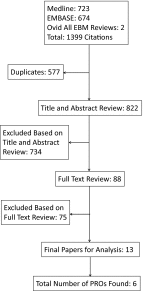What clinimetric evidence exists for using hip-specific patient-reported outcome measures in pediatric hip impingement?
- PMID: 25367111
- PMCID: PMC4353531
- DOI: 10.1007/s11999-014-4027-6
What clinimetric evidence exists for using hip-specific patient-reported outcome measures in pediatric hip impingement?
Abstract
Background: Patient-reported outcomes (PROs) are an increasingly popular research tool used to evaluate the outcomes of surgical intervention. If applied appropriately, they can be useful both for disease monitoring and as a method of assessing the efficacy of treatment. Many disorders can lead to impingement in children and adolescents, but it is not clear if any PROs have been validated to evaluate outcomes in these populations.
Questions/purposes: We performed a systematic review of the literature to answer the following research questions: (1) Which hip-specific PROs are used in pediatric populations with impingement? (2) What clinimetric evidence exists for the use of these specific PROs in this population?
Methods: We performed two systematic searches of three databases (Medline, EMBASE, and Ovid All EBM Reviews). The first search aimed to identify specific PROs that have been applied to pediatric impingement populations. The second search aimed to find clinimetric evaluations of the PROs from the first search in this population.
Results: We found six hip-specific PROs applied in pediatric impingement: Harris Hip Score, modified Harris Hip Score, Iowa Hip Score, Merle d'Aubigné Hip Score, Hip Outcome Score, and Non-arthritic Hip Score. However, we found no papers validating any of these PROs in this population. Furthermore, we found no papers validating any of these PROs in any pediatric population.
Conclusions: A number of adult PROs have been applied in pediatric impingement disorders without evidence of validation in any pediatric population. Further work to develop and validate a hip-specific pediatric PRO is required.
Figures


Comment in
-
CORR Insights ®: What clinimetric evidence exists for using hip-specific patient-reported outcome measures in pediatric hip impingement?Clin Orthop Relat Res. 2015 Apr;473(4):1368-9. doi: 10.1007/s11999-014-4120-x. Epub 2014 Dec 24. Clin Orthop Relat Res. 2015. PMID: 25537812 Free PMC article. No abstract available.
References
-
- Aguilar CM, Neumayr LD, Eggleston BE, Earles AN, Robertson SM, Jergesen HE, Stulberg BN, Vichinsky EP. Clinical Evaluation of avascular necrosis in patients with sickle cell disease: Children’s Hospital Oakland Hip Evaluation Scale—a modification of the Harris hip score. Arch Phys Med Rehabil. 2005;86:1369–1375. doi: 10.1016/j.apmr.2005.01.008. - DOI - PubMed
Publication types
MeSH terms
LinkOut - more resources
Full Text Sources
Miscellaneous

